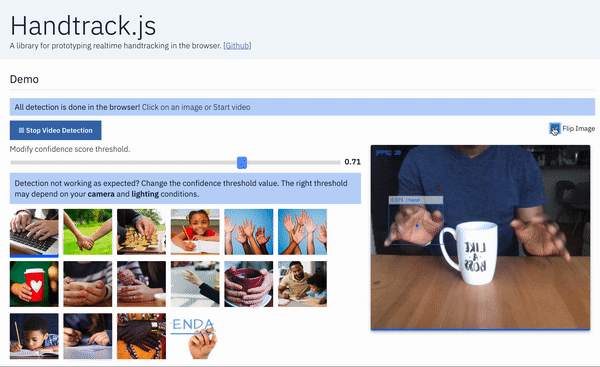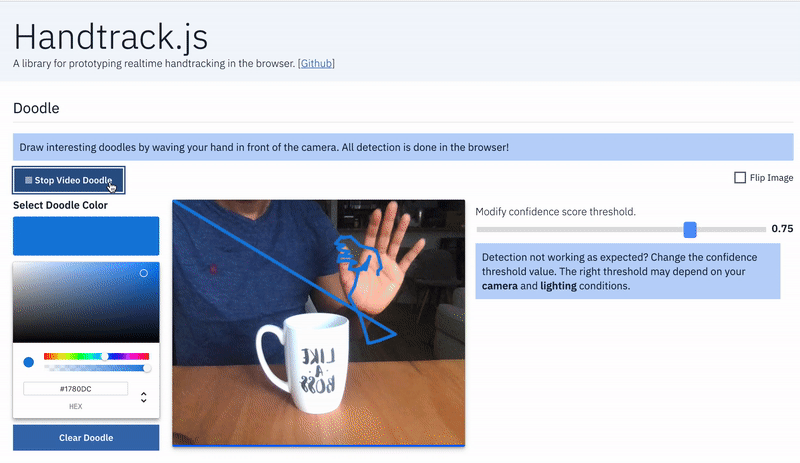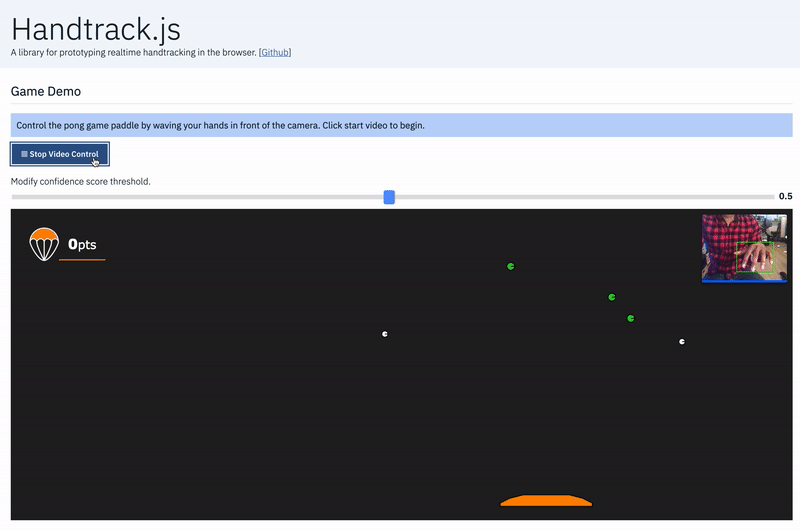View a live demo in your browser here.
Handtrack.js is a library for prototyping realtime hand detection (bounding box), directly in the browser. Underneath, it uses a trained convolutional neural network that provides bounding box predictions for the location of hands in an image. The convolutional neural network (ssdlite, mobilenetv2) is trained using the tensorflow object detection api (see here).
| FPS | Image Size | Device | Browser | Comments |
|---|---|---|---|---|
| 21 | 450 * 380 | Macbook Pro (i7, 2.2GHz, 2018) | Chrome Version 72.0.3626 | -- |
| 14 | 450 * 380 | Macbook Pro (i7, 2.2GHz, mid 2014) | Chrome Version 72.0.3626 | -- |
This work is based on the the coco-ssd tensorflowjs sample. Definitely check it out if you are interested in detecting/tracking any of the 90 classes in the coco dataset.
The library is provided as a useful wrapper to allow you prototype hand/gesture based interactions in your web applications. without the need to understand. It takes in a html image element (img, video, canvas elements, for example) and returns an array of bounding boxes, class names and confidence scores.
The library also provides some useful functions (e.g getFPS to get FPS, renderPredictions to draw bounding boxes on a canvas element), and customizable model parameters.
Tests on a Macbook Pro 2.2 GHz Intel Core i7, achieve 21 FPS.
- Trained using egohands dataset. You will notice the model works better when the hands in an image is viewed from a top (egocentic) view.
- Trained model is converted to the Tensorflowjs format
- Model is wrapped into an npm package, and can be accessed using jsdelivr, a free open source cdn that lets you include any npm package in your web application. You may notice the model is loaded slowly the first time the page is opened but gets faster on subsequent loads (caching).
If you are interested in prototyping gesture based (body as input) interactive experiences, Handtrack.js can be useful. The usser does not need to attach any additional sensors or hardware but can immediately take advantage of engagement benefits that result from gesture based and body-as-input interactions.
Code examples for the pong game control shown above is in the
demofolder.
Some (not all) relevant scenarios are listed below:
- When mouse motion can be mapped to hand motion for control purposes.
- When an overlap of hand and other objects can represent meaningful interaction signals (e.g a touch or selection event for an object).
- Scenarios where the human hand motion can be a proxy for activity recognition (e.g. automatically tracking movement activity from a video or images of individuals playing chess). Or simply counting how many humans are present in an image or video frame.
- You want an accessible demonstration that anyone can easily run or tryout with minimal setup.
You can use the library by including it in a javacript script tag.
<!-- Load the handtrackjs model. -->
<script src="https://cdn.jsdelivr.net/npm/handtrackjs/dist/handtrack.min.js"> </script>
<!-- Replace this with your image. Make sure CORS settings allow reading the image! -->
<img id="img" src="hand.jpg"/>
<canvas id="canvas" class="border"></canvas>
<!-- Place your code in the script tag below. You can also use an external .js file -->
<script>
// Notice there is no 'import' statement. 'handTrack' and 'tf' is
// available on the index-page because of the script tag above.
const img = document.getElementById('img');
const canvas = document.getElementById('canvas');
const context = canvas.getContext('2d');
// Load the model.
handTrack.load().then(model => {
// detect objects in the image.
model.detect(img).then(predictions => {
console.log('Predictions: ', predictions);
});
});
</script>npm install --save handtrackjsimport * as handTrack from 'handtrackjs';
const img = document.getElementById('img');
// Load the model.
handTrack.load().then(model => {
// detect objects in the image.
console.log("model loaded")
model.detect(img).then(predictions => {
console.log('Predictions: ', predictions);
});
});Once you include the js module, it is available as handTrack. You can then load a model with optional parameters.
const modelParams = {
flipHorizontal: true, // flip e.g for video
imageScaleFactor: 0.7, // reduce input image size for gains in speed.
maxNumBoxes: 20, // maximum number of boxes to detect
iouThreshold: 0.5, // ioU threshold for non-max suppression
scoreThreshold: 0.79, // confidence threshold for predictions.
}
handTrack.load(modelParams).then(model => {
});Returns a model object.
model.detect takes an input image element (can be an img, video, canvas tag) and returns an array of bounding boxes with class name and confidence level.
model.detect(img).then(predictions => {
});Returns an array of classes and confidence scores that looks like:
[{
bbox: [x, y, width, height],
class: "hand",
score: 0.8380282521247864
}, {
bbox: [x, y, width, height],
class: "hand",
score: 0.74644153267145157
}]model.getFPS(): get FPS calculated as number of detections per second.model.renderPredictions(predictions, canvas, context, mediasource): draw bounding box (and the input mediasource image) on the specified canvas.predictionsare an array of results from thedetect()method.canvasis a reference to a html canvas object where the predictions should be rendered,contextis the canvas 2D context object,mediasourcea reference to the input frame (img, video, canvas etc) used in the prediction (it is first rendered, and the bounding boxes drawn on top of it).model.getModelParameters(): returns model parameters.model.setModelParameters(modelParams): updates model parameters withmodelParamsdispose(): delete model instancestartVideo(video): start webcam video stream on given video element. Returns a promise that can be used to validate if user provided video permission.stopVideo(video): stop video stream.
Commands below runs the demo example in the demo folder.
npm install
npm run start
The start script launches a simple python3 webserver from the demo folder using http.server. You should be able to view it in your browser at http://localhost:3005/. You can also view the pong game control demo on same link http://localhost:3005/pong.html
The object detection model used in this project was trained using annotated images of the human hand (see here) and converted to the tensorflow.js format. This wrapper library was created using guidelines and some code adapted from the coco-ssd tensorflowjs.
Citing this Work (see abstract)
Paper abstract of the paper is here. (a full paper will be added when complete).
If you use this code in your project/paper/research and would like to cite this work, use the below.
Victor Dibia, HandTrack: A Library For Prototyping Real-time Hand TrackingInterfaces using Convolutional Neural Networks, https://github.com/victordibia/handtracking
@article{Dibia2017,
author = {Victor, Dibia},
title = {HandTrack: A Library For Prototyping Real-time Hand TrackingInterfaces using Convolutional Neural Networks},
year = {2017},
publisher = {GitHub},
journal = {GitHub repository},
url = {https://github.com/victordibia/handtracking/tree/master/docs/handtrack.pdf},
}- This thing is still compute heavy (your fans may spin after while). This is mainly because of the neural net operations needed to predict bounding boxes. Perhaps there might be ways to improve/optimize this.
- Tracking id's across frames. Perhaps some nifty methods that assigns ids to each had as they enter a frame and tracks them (e.g based on naive euclidean distance).
- Add some discrete poses (e.g. instead of just hand, detect open hand, fist).




